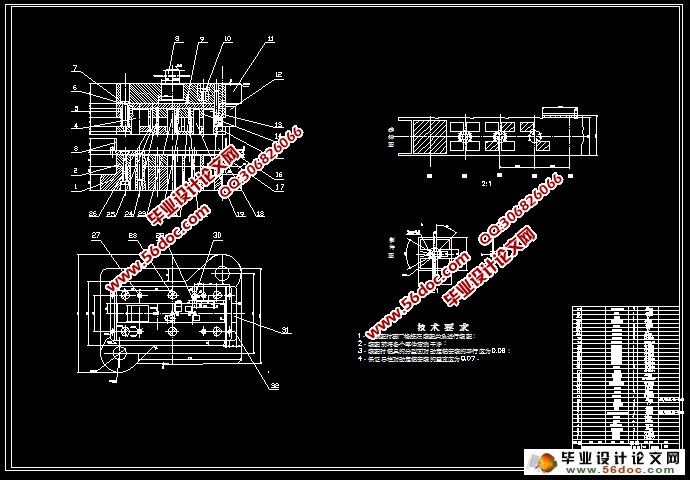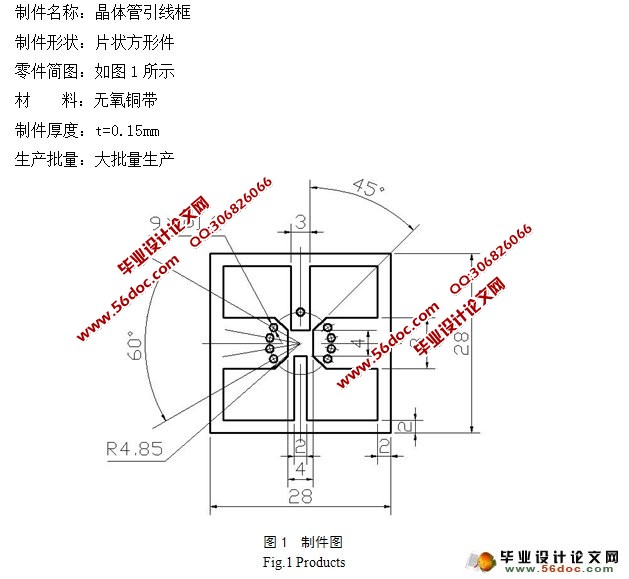晶体管引线框多工位级进模设计(含CAD零件图装配图)
无需注册登录,支付后按照提示操作即可获取该资料.
晶体管引线框多工位级进模设计(含CAD零件图装配图)(开题报告,中期检查表,论文说明书9000字,CAD图12张)
摘 要:该毕业设计是对晶体管引线框的制造工艺进行的整体分析, 在这个基础上设计出一套能够生产出合格产品的模具。此级进模主要工艺主要有冲孔、落料等。模具的设计主要包括有排样设计,凸模、凹模刃口尺寸的设计计算、冲压力的计算及模具压力中心的确定、模具非标准件的设计计算、压力机的选择及其校核。
关键词:工艺;级进模;冲孔;落料;凸模;凹模;刃口;设计计算
The Design Of Multi-Position Transfer Die For Transistor Lead Frame
Abstract:The graduation design is on global analysis of the manufacturing process of transfer die for transistor lead frame,and on the basis of the analysis we can work out a kind of die which can produce proper products.The major processes of the transfer die are piercing,blanking and so on.The design of the die mainly including layout design,the design and calculation of blade sizes of the punch and matrix,stamping force calculation and the determination of the pressure center,the design calculation of non-standard parts,the selection and the cerification of press machine.
Key words:process;transfer die;punching;blanking;punch;matrix;blade;design and calculation




目 录
摘要…………………………………………………………………………………………1
关键词………………………………………………………………………………………1
1前言………………………………………………………………………………………2
2制件的分析………………………………………………………………………………3
2.1制件结构分析………………………………………………………………………3
3冲压方案的确定……………………………………………………………………………3
3.1 排样的设计计算………………………………………………………………4
3.2 冲压力的计算……………………………………………………………………4
3.2.1板料和侧导板的尺寸………………………………………………………4
3.2.2冲裁力的计算………………………………………………………………5
3.3 模具压力中心的计算……………………………………………………………8
4模具的计算…………………………………………………………………………………9
4.1 凸凹模刃口尺寸的确定…………………………………………………………10
4.1.4 A区凹凸模刃口尺寸的确定……………………………………………10
4.1.2 B区凹凸模刃口尺寸的确定……………………………………………11
4.1.3 C区凹凸模刃口尺寸的确定……………………………………………13
4.1.4 D区凹凸模刃口尺寸的确定……………………………………………14
4.2 凹凸模的结构设计………………………………………………………………14
4.2.1 凸模结构设计……………………………………………………………14
4.2.2 凹模结构设计……………………………………………………………15
4.3 定位、导向、卸料装置的设计…………………………………………………16
4.3.1 侧刃和侧刃挡块…………………………………………………………16
4.3.2 导料板……………………………………………………………………17
4.3.3 导向零件…………………………………………………………………17
4.3.4 卸料装置…………………………………………………………………17
4.3.5 弹簧………………………………………………………………………17
5 模具闭合高度的计算和校核压力机的选择……………………………………………18
5.1 模具闭合高度的计算……………………………………………………………18
5.2 压力机的选择及校核……………………………………………………………19
6结论……………………………………………………………………………………19
参考文献……………………………………………………………………………………21
致谢…………………………………………………………………………………………22
